YII 授权(Authorization)
发布于 2015-08-01 11:20:40 | 512 次阅读 | 评论: 0 | 来源: 网络整理
Note: This section is under development.
Authorization is the process of verifying that a user has enough permission to do something. Yii provides two authorization methods: Access Control Filter (ACF) and Role-Based Access Control (RBAC).
Access Control Filter
Access Control Filter (ACF) is a simple authorization method that is best used by applications that only need some simple access control. As its name indicates, ACF is an action filter that can be attached to a controller or a module as a behavior. ACF will check a set of yiifiltersAccessControl::rules to make sure the current user can access the requested action.
The code below shows how to use ACF which is implemented as yiifiltersAccessControl:
use yiifiltersAccessControl;
class SiteController extends Controller
{
public function behaviors()
{
return [
'access' => [
'class' => AccessControl::className(),
'only' => ['login', 'logout', 'signup'],
'rules' => [
[
'allow' => true,
'actions' => ['login', 'signup'],
'roles' => ['?'],
],
[
'allow' => true,
'actions' => ['logout'],
'roles' => ['@'],
],
],
],
];
}
// ...
}
In the code above ACF is attached to the site controller as a behavior. This is the typical way of using an action filter. The only option specifies that the ACF should only be applied to login, logout and signup actions. The rules option specifies the yiifiltersAccessRule, which reads as follows:
- Allow all guest (not yet authenticated) users to access 'login' and 'signup' actions. The
rolesoption contains a question mark?which is a special token recognized as "guests". - Allow authenticated users to access 'logout' action. The
@character is another special token recognized as authenticated users.
When ACF performs authorization check, it will examine the rules one by one from top to bottom until it finds a match. The allow value of the matching rule will then be used to judge if the user is authorized. If none of the rules matches, it means the user is NOT authorized and ACF will stop further action execution.
By default, ACF does only the following when it determines a user is not authorized to access the current action:
- If the user is a guest, it will call yiiwebUser::loginRequired(), which may redirect the browser to the login page.
- If the user is already authenticated, it will throw a yiiwebForbiddenHttpException.
You may customize this behavior by configuring the yiifiltersAccessControl::denyCallback property:
[
'class' => AccessControl::className(),
'denyCallback' => function ($rule, $action) {
throw new Exception('You are not allowed to access this page');
}
]
yiifiltersAccessRule support many options. Below is a summary of the supported options. You may also extend yiifiltersAccessRule to create your own customized access rule classes.
-
yiifiltersAccessRule::allow: specifies whether this is an "allow" or "deny" rule.
-
yiifiltersAccessRule::actions: specifies which actions this rule matches. This should be an array of action IDs. The comparison is case-sensitive. If this option is empty or not set, it means the rule applies to all actions.
-
yiifiltersAccessRule::controllers: specifies which controllers this rule matches. This should be an array of controller IDs. The comparison is case-sensitive. If this option is empty or not set, it means the rule applies to all controllers.
-
yiifiltersAccessRule::roles: specifies which user roles that this rule matches. Two special roles are recognized, and they are checked via yiiwebUser::isGuest:
?: matches a guest user (not authenticated yet)@: matches an authenticated user
Using other role names requires RBAC (to be described in the next section), and yiiwebUser::can() will be called. If this option is empty or not set, it means this rule applies to all roles.
-
yiifiltersAccessRule::ips: specifies which yiiwebRequest::userIP this rule matches. An IP address can contain the wildcard
*at the end so that it matches IP addresses with the same prefix. For example, '192.168.*' matches all IP addresses in the segment '192.168.'. If this option is empty or not set, it means this rule applies to all IP addresses. -
yiifiltersAccessRule::verbs: specifies which request method (e.g.
GET,POST) this rule matches. The comparison is case-insensitive. -
yiifiltersAccessRule::matchCallback: specifies a PHP callable that should be called to determine if this rule should be applied.
-
yiifiltersAccessRule::denyCallback: specifies a PHP callable that should be called when this rule will deny the access.
Below is an example showing how to make use of the matchCallback option, which allows you to write arbitrary access check logic:
use yiifiltersAccessControl;
class SiteController extends Controller
{
public function behaviors()
{
return [
'access' => [
'class' => AccessControl::className(),
'only' => ['special-callback'],
'rules' => [
[
'actions' => ['special-callback'],
'allow' => true,
'matchCallback' => function ($rule, $action) {
return date('d-m') === '31-10';
}
],
],
],
];
}
// Match callback called! This page can be accessed only each October 31st
public function actionSpecialCallback()
{
return $this->render('happy-halloween');
}
}
Role based access control (RBAC)
Role-Based Access Control (RBAC) provides a simple yet powerful centralized access control. Please refer to the Wikipedia for details about comparing RBAC with other more traditional access control schemes.
Yii implements a General Hierarchical RBAC, following the NIST RBAC model. It provides the RBAC functionality through the yiirbacManagerInterface application component.
Using RBAC involves two parts of work. The first part is to build up the RBAC authorization data, and the second part is to use the authorization data to perform access check in places where it is needed.
To facilitate our description next, we will first introduce some basic RBAC concepts.
Basic Concepts
A role represents a collection of permissions (e.g. creating posts, updating posts). A role may be assigned to one or multiple users. To check if a user has a specified permission, we may check if the user is assigned with a role that contains that permission.
Associated with each role or permission, there may be a rule. A rule represents a piece of code that will be executed during access check to determine if the corresponding role or permission applies to the current user. For example, the "update post" permission may have a rule that checks if the current user is the post creator. During access checking, if the user is NOT the post creator, he/she will be considered not having the "update post" permission.
Both roles and permissions can be organized in a hierarchy. In particular, a role may consist of other roles or permissions; and a permission may consist of other permissions. Yii implements a partial order hierarchy which includes the more special tree hierarchy. While a role can contain a permission, it is not true vice versa.
Configuring RBAC Manager
Before we set off to define authorization data and perform access checking, we need to configure the yiibaseApplication::authManager application component. Yii provides two types of authorization managers: yiirbacPhpManager and yiirbacDbManager. The former uses a PHP script file to store authorization data, while the latter stores authorization data in a database. You may consider using the former if your application does not require very dynamic role and permission management.
configuring authManager with PhpManager
The following code shows how to configure the authManager in the application configuration using the yiirbacPhpManager class:
return [
// ...
'components' => [
'authManager' => [
'class' => 'yiirbacPhpManager',
],
// ...
],
];
The authManager can now be accessed via Yii::$app->authManager.
Tip: By default, yiirbacPhpManager stores RBAC data in files under
@app/rbac/directory. Make sure the directory and all the files in it are writable by the Web server process if permissions hierarchy needs to be changed online.
configuring authManager with DbManager
The following code shows how to configure the authManager in the application configuration using the yiirbacDbManager class:
return [
// ...
'components' => [
'authManager' => [
'class' => 'yiirbacDbManager',
],
// ...
],
];
DbManager uses four database tables to store its data:
- yiirbacDbManager::$itemTable: the table for storing authorization items. Defaults to "auth_item".
- yiirbacDbManager::$itemChildTable: the table for storing authorization item hierarchy. Defaults to "auth_item_child".
- yiirbacDbManager::$assignmentTable: the table for storing authorization item assignments. Defaults to "auth_assignment".
- yiirbacDbManager::$ruleTable: the table for storing rules. Defaults to "auth_rule".
Before you can go on you need to create those tables in the database. To do this, you can use the migration stored in @yii/rbac/migrations:
yii migrate --migrationPath=@yii/rbac/migrations
The authManager can now be accessed via Yii::$app->authManager.
Building Authorization Data
Building authorization data is all about the following tasks:
- defining roles and permissions;
- establishing relations among roles and permissions;
- defining rules;
- associating rules with roles and permissions;
- assigning roles to users.
Depending on authorization flexibility requirements the tasks above could be done in different ways.
If your permissions hierarchy doesn't change at all and you have a fixed number of users you can create a console command that will initialize authorization data once via APIs offered by authManager:
<?php
namespace appcommands;
use Yii;
use yiiconsoleController;
class RbacController extends Controller
{
public function actionInit()
{
$auth = Yii::$app->authManager;
// add "createPost" permission
$createPost = $auth->createPermission('createPost');
$createPost->description = 'Create a post';
$auth->add($createPost);
// add "updatePost" permission
$updatePost = $auth->createPermission('updatePost');
$updatePost->description = 'Update post';
$auth->add($updatePost);
// add "author" role and give this role the "createPost" permission
$author = $auth->createRole('author');
$auth->add($author);
$auth->addChild($author, $createPost);
// add "admin" role and give this role the "updatePost" permission
// as well as the permissions of the "author" role
$admin = $auth->createRole('admin');
$auth->add($admin);
$auth->addChild($admin, $updatePost);
$auth->addChild($admin, $author);
// Assign roles to users. 1 and 2 are IDs returned by IdentityInterface::getId()
// usually implemented in your User model.
$auth->assign($author, 2);
$auth->assign($admin, 1);
}
}
After executing the command with yii rbac/init we'll get the following hierarchy:
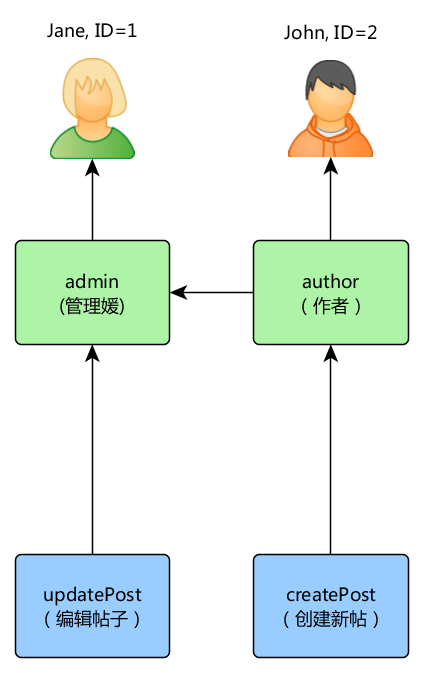
Author can create post, admin can update post and do everything author can.
If your application allows user signup you need to assign roles to these new users once. For example, in order for all signed up users to become authors in your advanced project template you need to modify frontendmodelsSignupForm::signup() as follows:
public function signup()
{
if ($this->validate()) {
$user = new User();
$user->username = $this->username;
$user->email = $this->email;
$user->setPassword($this->password);
$user->generateAuthKey();
$user->save(false);
// the following three lines were added:
$auth = Yii::$app->authManager;
$authorRole = $auth->getRole('author');
$auth->assign($authorRole, $user->getId());
return $user;
}
return null;
}
For applications that require complex access control with dynamically updated authorization data, special user interfaces (i.e. admin panel) may need to be developed using APIs offered by authManager.
Using Rules
As aforementioned, rules add additional constraint to roles and permissions. A rule is a class extending from yiirbacRule. It must implement the yiirbacRule::execute() method. In the hierarchy we've created previously author cannot edit his own post. Let's fix it. First we need a rule to verify that the user is the post author:
namespace apprbac;
use yiirbacRule;
/**
* Checks if authorID matches user passed via params
*/
class AuthorRule extends Rule
{
public $name = 'isAuthor';
/**
* @param string|integer $user the user ID.
* @param Item $item the role or permission that this rule is associated with
* @param array $params parameters passed to ManagerInterface::checkAccess().
* @return boolean a value indicating whether the rule permits the role or permission it is associated with.
*/
public function execute($user, $item, $params)
{
return isset($params['post']) ? $params['post']->createdBy == $user : false;
}
}
The rule above checks if the post is created by $user. We'll create a special permission updateOwnPost in the command we've used previously:
$auth = Yii::$app->authManager;
// add the rule
$rule = new apprbacAuthorRule;
$auth->add($rule);
// add the "updateOwnPost" permission and associate the rule with it.
$updateOwnPost = $auth->createPermission('updateOwnPost');
$updateOwnPost->description = 'Update own post';
$updateOwnPost->ruleName = $rule->name;
$auth->add($updateOwnPost);
// "updateOwnPost" will be used from "updatePost"
$auth->addChild($updateOwnPost, $updatePost);
// allow "author" to update their own posts
$auth->addChild($author, $updateOwnPost);
Now we've got the following hierarchy:
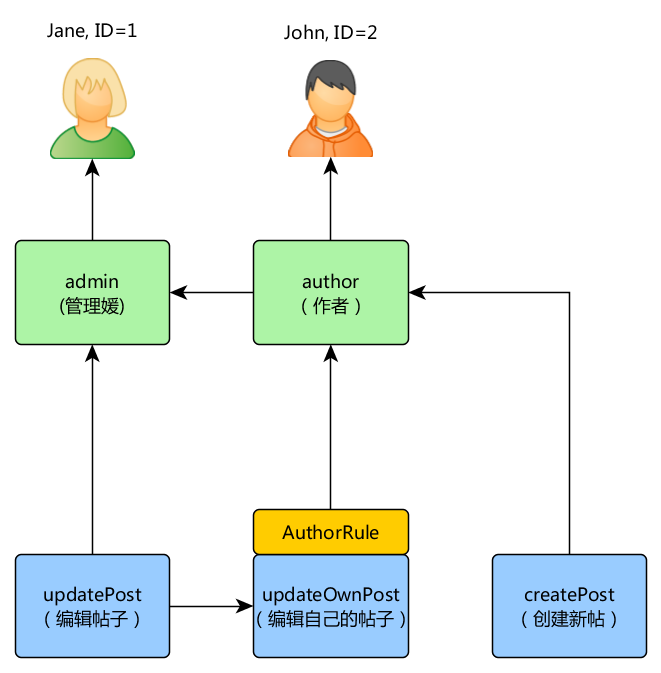
Access Check
With the authorization data ready, access check is as simple as a call to the yiirbacManagerInterface::checkAccess() method. Because most access check is about the current user, for convenience Yii provides a shortcut method yiiwebUser::can(), which can be used like the following:
if (Yii::$app->user->can('createPost')) {
// create post
}
If the current user is Jane with ID=1 we're starting at createPost and trying to get to Jane:
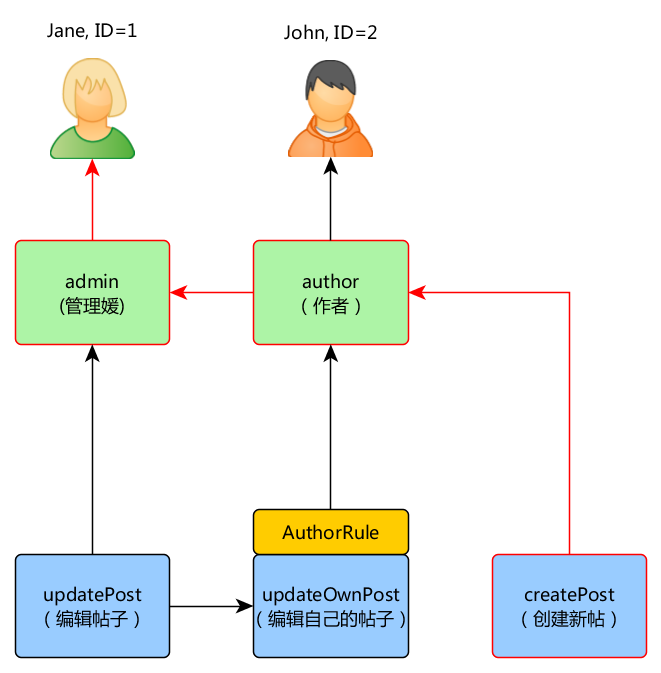
In order to check if user can update post we need to pass an extra parameter that is required by the AuthorRule described before:
if (Yii::$app->user->can('updatePost', ['post' => $post])) {
// update post
}
Here's what happens if current user is John:
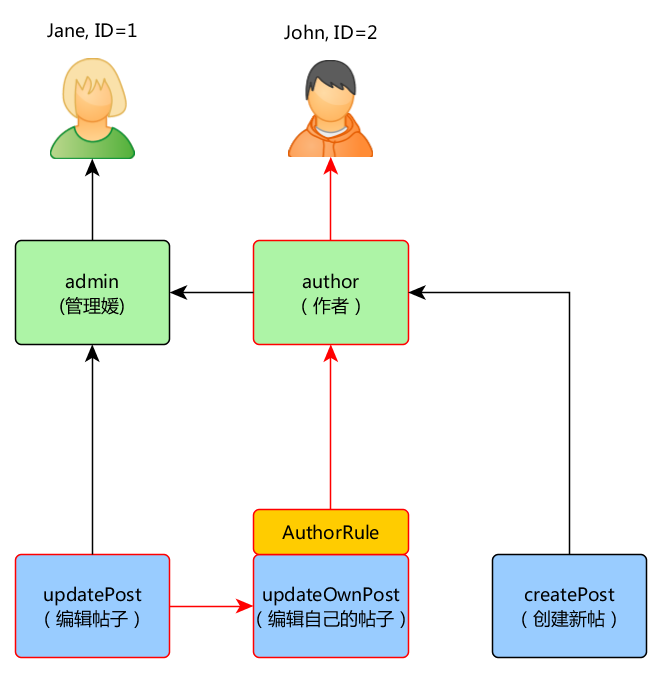
We're starting with the updatePost and going through updateOwnPost. In order to pass it AuthorRule should return true from its execute method. The method receives its $params from can method call so the value is ['post' => $post]. If everything is OK we're getting to author that is assigned to John.
In case of Jane it is a bit simpler since she's an admin:
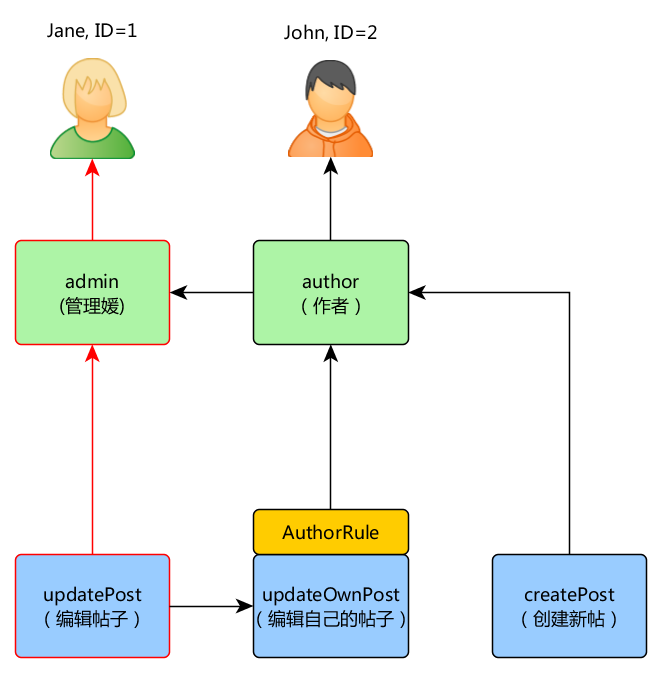
Using Default Roles
A default role is a role that is implicitly assigned to all users. The call to yiirbacManagerInterface::assign() is not needed, and the authorization data does not contain its assignment information.
A default role is usually associated with a rule which determines if the role applies to the user being checked.
Default roles are often used in applications which already have some sort of role assignment. For example, an application may have a "group" column in its user table to represent which privilege group each user belongs to. If each privilege group can be mapped to a RBAC role, you can use the default role feature to automatically assign each user to a RBAC role. Let's use an example to show how this can be done.
Assume in the user table, you have a group column which uses 1 to represent the administrator group and 2 the author group. You plan to have two RBAC roles admin and author to represent the permissions for these two groups, respectively. You can set up the RBAC data as follows,
namespace apprbac;
use Yii;
use yiirbacRule;
/**
* Checks if user group matches
*/
class UserGroupRule extends Rule
{
public $name = 'userGroup';
public function execute($user, $item, $params)
{
if (!Yii::$app->user->isGuest) {
$group = Yii::$app->user->identity->group;
if ($item->name === 'admin') {
return $group == 1;
} elseif ($item->name === 'author') {
return $group == 1 || $group == 2;
}
}
return false;
}
}
$auth = Yii::$app->authManager;
$rule = new apprbacUserGroupRule;
$auth->add($rule);
$author = $auth->createRole('author');
$author->ruleName = $rule->name;
$auth->add($author);
// ... add permissions as children of $author ...
$admin = $auth->createRole('admin');
$admin->ruleName = $rule->name;
$auth->add($admin);
$auth->addChild($admin, $author);
// ... add permissions as children of $admin ...
Note that in the above, because "author" is added as a child of "admin", when you implement the execute() method of the rule class, you need to respect this hierarchy as well. That is why when the role name is "author", the execute() method will return true if the user group is either 1 or 2 (meaning the user is in either "admin" group or "author" group).
Next, configure authManager by listing the two roles in yiirbacBaseManager::$defaultRoles:
return [
// ...
'components' => [
'authManager' => [
'class' => 'yiirbacPhpManager',
'defaultRoles' => ['admin', 'author'],
],
// ...
],
];
Now if you perform an access check, both of the admin and author roles will be checked by evaluating the rules associated with them. If the rule returns true, it means the role applies to the current user. Based on the above rule implementation, this means if the group value of a user is 1, the admin role would apply to the user; and if the group value is 2, the author role would apply.